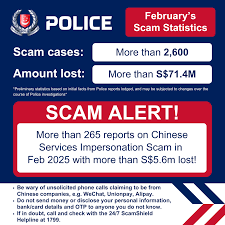Analysis of Credit Card and Shopping Scams with Singapore’s Anti-Scam Measures
.gif?width=600&height=397&name=Onlyfake%20website%20(1).gif)
1. Random Card Number Generator Scams
Scammers use technology to generate random credit card numbers, testing them with small transactions until they find valid combinations with correct expiry dates. Once validated, they proceed to more significant fraudulent transactions.
2. Digital Card Skimming
Unlike traditional physical skimming, online skimmers inject fake payment forms on websites to collect card data. These forms often mimic legitimate services like PayPal to deceive shoppers.
3. Voice Phishing (Vishing)
Scammers impersonate authority figures, often using the +65 prefix in Singapore, to trick victims into providing sensitive information. There have been cases of scammers pretending to be from organizations like MOH, with reported losses of over $1.2 million.
4. Card Misuse by Known Persons
This involves the unauthorized use of card details by someone known to the cardholder, such as family members or friends. These people often set up recurring payments or make in-app purchases that might not trigger OTP notifications.
5. Wireless Identity Theft
This includes tactics like SMS OTP diversion, where scammers manipulate sender IDs to appear in the same message thread as legitimate bank communications, creating convincing phishing opportunities.
6. Internet Merchandise Scams
These involve fake sellers offering items at suspiciously low prices or requiring only shipping fees. Cash-on-delivery scams are another variant where victims pay for inferior or entirely different products.
7. Fake Bank Hotlines
Scammers create fraudulent advertisements with fake bank contact numbers that appear in search results, then impersonate bank staff to convince victims to transfer funds to “secure” accounts.
Singapore’s Anti-Scam Measures
Regulatory and Institutional Measures
- Singapore Police Force Anti-Scam Centre: Established to combat online scams through collaboration with banks and digital platforms.
- ScamShield App: Developed by the National Crime Prevention Council and Government Technology Agency to block known scam calls and filter scam SMSs.
- Banking Security Protocols: Singapore banks have implemented enhanced verification processes, including:
- Mandatory cooling-off periods for digital token activations
- Removal of clickable links in emails and SMS communications
- Reduced transaction limits for higher-risk transactions
- Project OASIS (Online Anti-Scam Investigation System): This uses artificial intelligence to identify and freeze suspicious bank accounts.
Public Education Initiatives
- Anti-Scam Campaigns: Ongoing public awareness campaigns by the police and relevant agencies.
- Community Vigilance Programs: Encouraging reporting of suspicious activities and sharing information about recent scams.
- Bank Educational Resources: Financial institutions like DBS have dedicated online security pages with updated information on emerging scams.
Technology Solutions
- Two-factor authentication (2FA): Widely implemented across Singapore’s financial services.
- Customizable Payment Controls: Banks offer features to temporarily lock cards, disable online transactions, and set spending limits.
- Transaction Notifications: Real-time alerts for transactions exceeding predetermined thresholds.
Best Practices for Consumers
- Verify Communication Channels: Always cross-check contact numbers with official websites.
- Scrutinize URLs and Links: Be wary of shortened links and check website security (padlock icon).
- Regular Account Monitoring: Frequently check bank statements for unauthorized transactions.
- Report Promptly: Immediately report suspicious activities to banks and lodge police reports for fraudulent transactions.
- Use Dedicated Shopping Cards: Consider having a separate debit card with limited funds for online shopping.
The integration of regulatory oversight, technological solutions, and public education has helped Singapore develop a relatively robust anti-scam ecosystem. However, the evolving nature of scams requires continuous adaptation of these measures.
Detailed Analysis of Credit Card Scams & Singapore’s Anti-Scam Support Systems
Credit Card Scams: In-Depth Analysis
1. Random Card Number Generator Scams
This sophisticated technique uses algorithms to generate potential credit card numbers following industry patterns. Scammers:
- Use software to produce thousands of possible card numbers
- Test generated numbers with small transactions (often under $1) that often go unnoticed
- Methodically test different expiry date combinations
- Once validated, escalate to more significant transactions or sell the confirmed card details on dark web marketplaces
- Often target cards with high spending limits or premium status
2. Digital Card Skimming (E-Skimming)
Unlike traditional physical skimming, this involves:
- Injecting malicious JavaScript code into legitimate websites’ payment pages
- Creating Magecart attacks targeting e-commerce platforms
- Establishing fake payment processing pages that mirror trusted services
- Harvesting details in real-time as customers enter information
- Immediate transmission of stolen data to scammers’ servers before payment completion
3. Voice Phishing (Vishing) Techniques
Singapore-specific tactics include:
- Caller ID spoofing with local prefixes (+65)
- Impersonation of government authorities (MOH, police, courts)
- Creation of artificial urgency through threats of legal action or account suspension
- Use of call forwarding to intercept bank verification calls
- Multi-stage approaches that establish credibility before requesting sensitive information
4. Card Misuse by Known Persons
This involves the exploitation of existing relationships:
- Setting up recurring small-value payments that fly under notification thresholds
- Adding cards to digital wallets or gaming platforms for ongoing access
- Memorizing card details from temporarily accessing physical cards
- Exploiting trusted relationships to bypass security measures
- Using social engineering within personal relationships to gain access to PINs or OTPs
5. Wireless Identity Theft
These technical attacks include:
- SMS redirection through SIM swapping or telecom network vulnerabilities
- Man-in-the-middle attacks intercepting OTPs or verification codes
- Creation of fraudulent but convincing SMS threads that blend with legitimate messages
- Exploitation of bank transaction message formats to create believable phishing attempts
- Use of specialized phishing kits explicitly designed for Singaporean banks
Singapore’s Anti-Scam Support Ecosystem
Government Resources
1. ScamShield
- Free app developed by National Crime Prevention Council and GovTech
- Blocks calls from known scam numbers
- Filters and warns about potential scam SMSes
- Reports new scam attempts to authorities automatically
- Regular updates to keep pace with emerging threats
2. Anti-Scam Centre (ASC)
- Established in 2019 by the Singapore Police Force
- Coordinates between banks, telecommunications companies, and digital platforms
- Worked on over 5,000 cases within the first year of operation
- Implemented rapid response protocols for fund recovery
- Achieved recovery of approximately 35% of scammed monies in successful cases
3. Scam Alert Website and Hotline
- Dedicated portal with updated information about recent scams
- 24/7 anti-scam hotline (1800-722-6688)
- Provides verification services for suspicious contacts
- Maintains a database of known scam techniques and variations
- Offers step-by-step guidance for scam victims
Banking Sector Support
1. DBS/POSB Anti-Scam Initiatives
- Payment Controls feature allowing customers to set transaction limits
- Option to temporarily lock cards not in use
- Ability to disable specific transaction types (online payments, overseas use)
- Real-time notification system for transactions
- Dedicated fraud detection team monitoring unusual patterns
2. Association of Banks in Singapore (ABS) Guidelines
- Industry-wide security standards for digital banking
- Removal of clickable links in official communications
- Implementation of cooling-off periods for digital token activation
- Transaction notification thresholds standardized across institutions
- Cross-bank coordination for suspicious transaction reporting
3. Customer Support Protocols
- Dedicated anti-fraud hotlines at major banks
- 24/7 card blocking services across all Singapore banks
- Emergency response teams for potential fraud cases
- Specialized investigation units for complex cases
- Provisional credit systems while investigations proceed
Community Support Networks
1. Victim Support Resources
- National Crime Prevention Council counseling services
- Community-based support groups for scam victims
- Financial counseling for those experiencing significant losses
- Legal aid services for complex cases requiring litigation
- Mental health support for the psychological impact of scams
2. Public Education Initiatives
- Regular roadshows in community centers and public spaces
- School-based digital literacy programs focusing on fraud prevention
- Senior-focused workshops addressing standard targeting of elderly
- Multilingual education materials reflecting Singapore’s diverse population
- Business-specific training for company financial controllers
Reporting Mechanisms
1. Police Reporting
- Online police reporting system specific to scam cases
- Specialized interview protocols for gathering technical details
- Cross-border cooperation with international authorities
- Case tracking system for victims to follow investigation progress
- Data aggregation to identify trends and emerging threats
2. Bank Reporting
- Immediate card-freezing options across multiple channels
- Dispute resolution systems for unauthorized transactions
- Evidence collection protocols for digital transactions
- Reimbursement policies for proven fraud cases
- Post-incident security reviews to prevent recurrence
Effectiveness and Challenges
Singapore’s multi-pronged approach has shown success in certain areas, but challenges remain:
Successes
- Increase in scam awareness among the general population
- Improved fund recovery rates when reported quickly
- Reduced response time between reporting and account freezing
- Greater coordination between banks and law enforcement
- Development of technological tools to combat scams
Ongoing Challenges
- Increasingly sophisticated scamming techniques
- The cross-border nature of many scams makes prosecution difficult
- Balance between security measures and user convenience
- Psychological factors making victims reluctant to report
- Keeping pace with rapidly evolving digital payment systems
For individuals experiencing credit card fraud in Singapore, the most effective approach is a combination of preventive vigilance and knowing exactly which resources to access when incidents occur. Singapore’s integrated anti-scam ecosystem provides multiple avenues for support, though timeliness remains critical in resolving cases successfully.
Anti-Scam Help in Singapore
Government Resources
- ScamShield App: Developed by the Singapore government, this app blocks known scam calls and messages. It filters out scam messages and calls from phone numbers used in other scam cases.
- Anti-Scam Centre (ASC): Established by the Singapore Police Force, the ASC works with banks to freeze suspicious accounts and recover stolen funds. They’ve reported recovering millions of dollars for victims.
- National Crime Prevention Council’s Scam Alert Website: This website provides real-time updates on emerging scams and allows the public to report scams they encounter.
- ScamAlert Hotline: A dedicated 24-hour hotline (1800-722-6688) where individuals can verify suspicious messages or calls.
Financial Institution Support
- Bank Security Measures: Major banks have implemented cooling-off periods for first-time fund transfers to new recipients and lowered default transaction limits.
- OCBC’s Digital Security Notification Service: Alerts customers when suspicious transactions are detected.
- DBS’s Anti-Scam Suite includes features like “Funds Lock,” which allows customers to instantly freeze their accounts if they suspect they’ve been scammed.
Community Initiatives
- Scam Support Centre: This centre provides counseling and practical assistance to scam victims, helping them navigate the process of reporting and recovering from scams.
- Senior Digital Wellness Programme: Trains older adults to recognize and avoid digital scams.
- SG Cyber Safe Students Programme: Educates students about cybersecurity and scam awareness.
Recovery Process
If someone becomes a victim of a scam in Singapore:
- Report to the police immediately through the online Police Report portal
- Contact your bank to freeze accounts and attempt to recover funds
- Report the scam to the Anti-Scam Centre
- Preserve evidence including messages, screenshots, and transaction records
- Change passwords for all important accounts
- Seek support from the Scam Support Centre if needed
Singapore has made scam prevention a national priority, collaborating with government agencies, financial institutions, telecommunications companies, and community organizations to combat the rising threat of scams.
- Some scammers don’t hide their identity because they operate from outside victims’ jurisdictions.
Current Prevention Measures
- Singapore’s framework makes financial institutions and telcos accountable
- “Money lock” initiative by banks that prevents remote access to a portion of funds
- Anti-scam awareness campaigns (though these are often quickly outpaced by scammers)
Expert Perspective
Jorij Abraham, Gasa’s managing director, believes:
- It’s now “inevitable” that everyone will fall victim to scams at some point.
- Protection requires government and institutional involvement at an infrastructural level.
- Perfect prevention is impossible unless “you haven’t taken any risks and lived”
1. E-Commerce Scams

Trend Details
- 11,665 cases in 2024
- 19.23% increase from 2023
- Total losses: $17.5 million
- Average loss: $1,508 per case
Notable Example
A scammer named Foo Mei Qi:
- Defrauded 76 victims of $110,700 through fake Taylor Swift concert tickets
- Sold counterfeit tickets totalling $7,780
- Operated primarily on Carousell

Prevention Methods
- Never make payments before receiving items
- Be extra cautious on messaging platforms like Telegram
- Verify seller credentials thoroughly
- Be sceptical of deals for high-demand, sold-out items
- Use secure payment methods with buyer protection
- Meet sellers in safe, public locations for transactions
- Check the seller’s profile, reviews, and transaction history

Prevention Methods
- Never pay money to get a job
- Be wary of unsolicited job offers
- Research the company thoroughly
- Check job listings through official channels
- Avoid roles requiring upfront personal investment
- Verify company contact information
- Be sceptical of jobs promising unusually high commissions
General Scam Prevention Tips
- Trust your instincts
- If an offer seems too good to be true, it probably is
- Keep personal and financial information confidential
- Stay informed about the latest scam techniques
- Report suspicious activities to authorities
- Educate family members, especially older relatives
- Use secure, updated technology
- Maintain a healthy level of skepticism online

Maxthon
Maxthon has set out on an ambitious journey aimed at significantly bolstering the security of web applications, fueled by a resolute commitment to safeguarding users and their confidential data. At the heart of this initiative lies a collection of sophisticated encryption protocols, which act as a robust barrier for the information exchanged between individuals and various online services. Every interaction—be it the sharing of passwords or personal information—is protected within these encrypted channels, effectively preventing unauthorised access attempts from intruders.
 This meticulous emphasis on encryption marks merely the initial phase of Maxthon’s extensive security framework. Acknowledging that cyber threats are constantly evolving, Maxthon adopts a forward-thinking approach to user protection. The browser is engineered to adapt to emerging challenges, incorporating regular updates that promptly address any vulnerabilities that may surface. Users are strongly encouraged to activate automatic updates as part of their cybersecurity regimen, ensuring they can seamlessly take advantage of the latest fixes without any hassle.
This meticulous emphasis on encryption marks merely the initial phase of Maxthon’s extensive security framework. Acknowledging that cyber threats are constantly evolving, Maxthon adopts a forward-thinking approach to user protection. The browser is engineered to adapt to emerging challenges, incorporating regular updates that promptly address any vulnerabilities that may surface. Users are strongly encouraged to activate automatic updates as part of their cybersecurity regimen, ensuring they can seamlessly take advantage of the latest fixes without any hassle.
In today’s rapidly changing digital environment, Maxthon’s unwavering commitment to ongoing security enhancement signifies not only its responsibility toward users but also its firm dedication to nurturing trust in online engagements. With each new update rolled out, users can navigate the web with peace of mind, assured that their information is continuously safeguarded against ever-emerging threats lurking in cyberspace.
